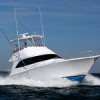Garmin GHP 20 Marine Autopilot System for Viking Owner's Manual - Page 21
gHC 10 USer settinGS
 |
View all Garmin GHP 20 Marine Autopilot System for Viking manuals
Add to My Manuals
Save this manual to your list of manuals |
Page 21 highlights
Configuring the GHC 10 Remote 1. From the Heading screen, select Menu > Setup > Remote. 2. Select an option: • Button 1 Action-set the function performed by the first button on the remote. • Button 2 Action-set the function performed by the second button on the remote. • Button 3 Action-set the function performed by the third button on the remote. • Disconnect Remote-disconnect the remote from the device. GHC 10 User Settings ‹ Caution On a GHP 10 autopilot system, if you disable the Shadow Drive, you must set the autopilot to standby (STBY) to manually control the helm. Use caution when disabling the Shadow Drive. On a GHP 10V autopilot system, if you disable the Shadow Drive, any adjustment to the helm completely disengages the autopilot. Although the autopilot is configured for your boat during installation, you may find it necessary to adjust it depending on sea conditions. Select Menu > Setup > User Autopilot Configuration. • Shadow Drive™-enables the device to enter standby mode automatically when you manually steer the helm, then engages the heading hold again when you hold a steady course for a few seconds. NOTE: The Shadow Drive is only available on hydraulic steering GHC 10 Owner's Manual Settings systems. • Shadow Drive Sensitivity-Shadow Drive is activated when a certain amount of pressure is placed on the helm. Adjust this setting if the Shadow Drive is being falsely tripped or not activating properly. If the autopilot disengages while the helm is steady, decreasing the sensitivity value can help alleviate unwanted disengaging. If the Shadow Drive does not disengage the autopilot correctly when you take the helm, increasing the sensitivity value may help. Note: This setting does not apply to a GHP 10V or GHP 12 autopilot system. • Sea State Filtering-adjust the sea state filtering to set the heading responsiveness. Set sea state filtering to 0% under normal operating conditions. Increase sea state filtering in choppy conditions at low speeds to reduce rudder activity and reduce wear on the autopilot system. • Direction Control-enable the device to set the drive direction to forward or reverse from the heading screen when the autopilot is in standby mode. See page 4 for information about using direction control. • Heading Hold Tack Angle-(sailboats only) set the fixed angle at which the autopilot performs a tack or gybe maneuver with heading hold engaged. Select an angle from 1° to 180°. • Tack/Gybe Delay-(sailboats only) the autopilot delays steering a tack or gybe after you initiate the maneuver using the remote or the device. The delay counts down on the heading screen, and sounds an alarm when the autopilot begins the tack or gybe. Select a delay from 0 to 15 seconds. • Gybe Inhibitor-(sailboats only) prevents the autopilot from performing a gybe. The gybe inhibitor does not prevent you from manually performing a gybe using the helm or step steering. 17















